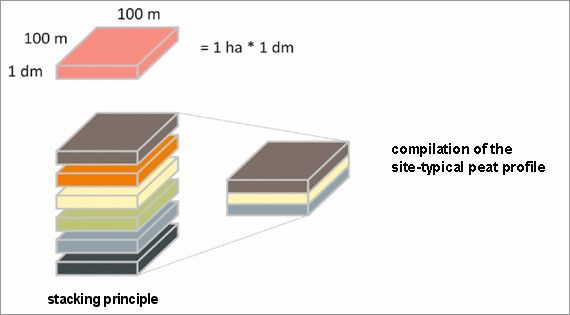Soil Types
Peat soils are in a category of their own in the classification of soils, since for no other soil the original material is formed together with the soil itself (Ad-hoc-AG Boden 2005). Thus a categorisation as peatland occurs if the soils consist of peats with more than 30 % by mass of organic substance and a thickness of at least 3 dm (including intercalated mineral layers and gyttja).
The map of the Soil Associations (SenStadtUm, Edition 2013a) with a scale of 1:50,000 does not represent the peat soils with sufficient spatial resolution and differentiation, since due to the conception and scale of the map peat soils are always combined into soil associations with other soil types. Due to the extensive terrain and laboratory records of the research project, Berlin’s peatlands can now be assessed better, and targeted adaptation strategies can be derived. A map of the soil types for the peatland sites was created at a scale of 1:5,000. In addition to the near-natural and drained peat soils, buried sites (e.g. construction waste deposits) and subhydric soils with high carbon content (e.g. sapropel) were also taken into account.
Within the research project, potential peatland areas were selected by intersecting the Geological Map of Prussia 1874 - 1937 (1:25,000, German only) and the Berlin Biotope Type Mapping (SenStadtUm, Edition 2012) - wetland biotopes - and were analysed and assessed according to the criteria of the German Soil Classification System (KA5, Ad-Hoc-AG Boden 2005). Recording peatland boundary points in the terrain and using the Digital Terrain Model (DGM1, Senatsverwaltung für Stadtentwicklung und Umwelt) allowed the peatland boundaries to be represented with high spatial resolution. The differentiation within the peatland areas is based on the polygons of the Biotope Type Mapping, on the assumption that identical biotope types represent similar soil properties of the topsoil (peat substrates, drainage depths). The location-related transfer of area-representative terrain profiles to the resulting peatland map was carried out using a geographic information system. A plausibility check was carried out; a manual correction was required only in few cases.
Carbon Stocks
In addition to the map that shows all Berlin peatland areas and their soil types (01.19.1), a further result of the research project is illustrated in the Environmental Atlas - the carbon stocks of the peatlands (01.19.2).
For assessing the carbon stocks, a ‘stacking system’ was put together from field and theoretical data, which covered 33 of the most prevalent soil horizons found in Berlin’s peatlands. The C storage quantities (Corg) per 1 ha land and 1 dm thickness were calculated for each of these horizons.
The stacking system allows the C storage quantities to be transferred to other peat soil horizons and soil profiles with similar soil and substrate properties (Figure 1). This allowed the C storage to be accurately determined for all of Berlin’s peatlands.


